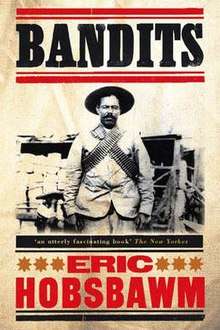Bandits (book)
 | |
| Author | Eric Hobsbawm |
|---|---|
| Country | United Kingdom, United States |
| Language | English |
| Subject | History, Criminology, Social banditry |
| Genre | Nonfiction |
| Publisher |
Weidenfeld & Nicolson (UK) World Publishing (US) |
Publication date | 1969 |
| Pages | 185 |
Bandits is a book by Eric Hobsbawm, first published in 1969. It focuses on the concept of bandits within the mythology, folklore, and literature of Europe, specifically it's relation to classical Marxist concepts of Class struggle.
Contents
- Chapter One: What is Social Banditry?
- Chapter Two Who becomes a Bandit?
- Chapter Three: The Noble Robber
- Chapter Four: The Avengers
- Chapter Five: Haiduks
- Chapter Six: The Economics of Politics and Banditry
- Chapter Seven: Bandits and Revolution
- Chapter Eight: The Expropriators
- Chapter Nine: The Bandit as Symbol
Summary
Eric Hobsbawm sets out to explore and analyze the history of banditry and organized crime and it's relationship to class structure's of agrarian societies. Hobsbawm specifies a specific form of crime that fit into the category of social bandit, who represented groups of young men, landless peasants, free-men, and militarydeserters. Social bandits are distinguished from other forms of organized crime in how the majority peasantry perceived the bandits as rebels who opposed the unjust system of feudalism. Among social bandits there are three main historical categories: that of "The Noble Robbers", "The Avengers", and the " haiduks". The Noble Robbers are the romanticized concept of noble criminals who fight injustice and have a large popularity with the lower classes; key figures include Robin Hood, DIego Corrientes and Juro Janosik.[1][2][3]
References
- ↑ Fronczak, Joseph. "Hobsbawm's Long Century". Jacobin. Jacobin. Retrieved 24 September 2018.
- ↑ Hobsbawm, Eric (12 March 1981). "Bandits". Pantheon.
- ↑ Anderson, Jon Lee. "Hobsbawm and the Bandits". The New Yorker. The New Yorker. Retrieved 24 September 2018.
External links